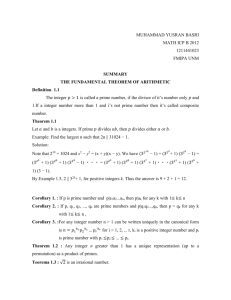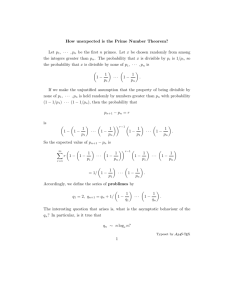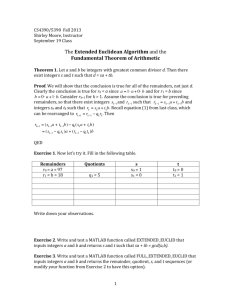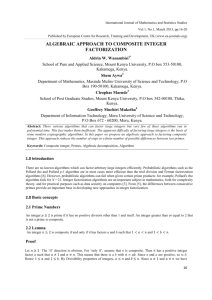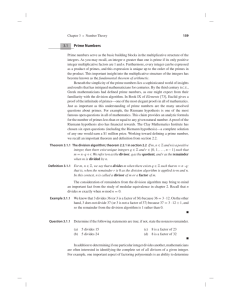Review of divisibility and primes
advertisement
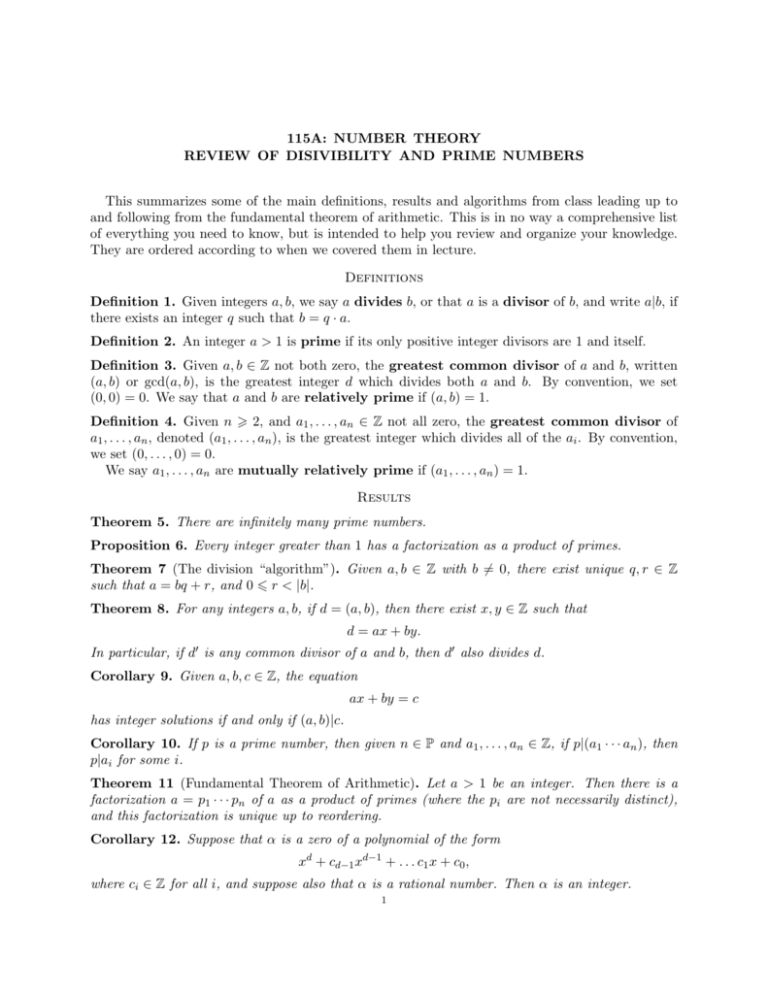
115A: NUMBER THEORY
REVIEW OF DISIVIBILITY AND PRIME NUMBERS
This summarizes some of the main definitions, results and algorithms from class leading up to
and following from the fundamental theorem of arithmetic. This is in no way a comprehensive list
of everything you need to know, but is intended to help you review and organize your knowledge.
They are ordered according to when we covered them in lecture.
Definitions
Definition 1. Given integers a, b, we say a divides b, or that a is a divisor of b, and write a|b, if
there exists an integer q such that b = q · a.
Definition 2. An integer a > 1 is prime if its only positive integer divisors are 1 and itself.
Definition 3. Given a, b ∈ Z not both zero, the greatest common divisor of a and b, written
(a, b) or gcd(a, b), is the greatest integer d which divides both a and b. By convention, we set
(0, 0) = 0. We say that a and b are relatively prime if (a, b) = 1.
Definition 4. Given n > 2, and a1 , . . . , an ∈ Z not all zero, the greatest common divisor of
a1 , . . . , an , denoted (a1 , . . . , an ), is the greatest integer which divides all of the ai . By convention,
we set (0, . . . , 0) = 0.
We say a1 , . . . , an are mutually relatively prime if (a1 , . . . , an ) = 1.
Results
Theorem 5. There are infinitely many prime numbers.
Proposition 6. Every integer greater than 1 has a factorization as a product of primes.
Theorem 7 (The division “algorithm”). Given a, b ∈ Z with b 6= 0, there exist unique q, r ∈ Z
such that a = bq + r, and 0 6 r < |b|.
Theorem 8. For any integers a, b, if d = (a, b), then there exist x, y ∈ Z such that
d = ax + by.
In particular, if
d0
is any common divisor of a and b, then d0 also divides d.
Corollary 9. Given a, b, c ∈ Z, the equation
ax + by = c
has integer solutions if and only if (a, b)|c.
Corollary 10. If p is a prime number, then given n ∈ P and a1 , . . . , an ∈ Z, if p|(a1 · · · an ), then
p|ai for some i.
Theorem 11 (Fundamental Theorem of Arithmetic). Let a > 1 be an integer. Then there is a
factorization a = p1 · · · pn of a as a product of primes (where the pi are not necessarily distinct),
and this factorization is unique up to reordering.
Corollary 12. Suppose that α is a zero of a polynomial of the form
xd + cd−1 xd−1 + . . . c1 x + c0 ,
where ci ∈ Z for all i, and suppose also that α is a rational number. Then α is an integer.
1
Proposition 13. Given a, b, c ∈ Z, suppose that the equation
ax + by = c
has a solution with x, y ∈ Z. Then it has infinitely many such solutions. More specifically, if x0 , y0
is any fixed solution, then every solution can be written in the form x = x0 +(b/d)q, y = y0 −(a/d)q,
where d = (a, b), and q ∈ Z.
Corollary 14. Given a, b, c ∈ Z, suppose that the equation
ax + by = c
has a solution with x, y ∈ Z. If a, b > 0, then there are at most finitely many solution with x, y > 0.
If x0 , y0 is any fixed solution, then the nonnegative solutions are of the form x = x0 + (b/d)q, y =
y0 − (a/d)q, with d = (a, b), and
−(d/b)x0 6 q 6 (d/a)y0 .
Theorem 15. Given a1 , . . . , an , b ∈ Z:
(i) the solutions to the equation
a1 x1 + · · · + an xn = b
(1)
with all the xi ∈ Z are the same as the solutions to the two equations
a1 x1 + · · · + an−2 xn−2 + (an−1 , an )w = b
(2)
and
(3)
an−1 xn−1 + an xn = (an−1 , an )w,
where w is also allowed to vary in Z;
(ii) the equation (1) has solutions if and only if
(a1 , . . . , an )|b,
and in this case, it has infinitely many solutions;
(iii) if all the ai and b are positive, then (1) has at most finitely many solutions with all the xi
nonnegative.
Algorithms
Algorithm 16 (Euclidean algorithm). Given nonzero integers a, b, set r0 = a, r1 = b and for i > 2,
as long as ri−1 6= 0, let ri be the remainder when dividing ri−2 by ri−1 . Let n be maximal with
rn 6= 0, and set d = rn . Then d = (a, b).
Algorithm 17 (Extended Euclidean algorithm). Given a, b, let qi be the quotient arising in the
ith step of the algorithm, so that ri−1 = ri qi + ri+1 . Then we can find x, y with
ax + by = d
as follows: let s0 = 1, s1 = 0, t0 = 0, t1 = 1, and then for i > 1 let
si = si−2 − qi−1 si−1 , and ti = ti−2 − qi−1 ti−1 .
Then
(a, b) = sn a + tn b.
Algorithm 18 (Trial division). Given an integer a > 1:
√
(I) Let S = {p1 < · · · < pn } be the primes less than or equal to a.
(II) Let i = 1, and b = a.
(III) divide pi into b as many times as possible, and let ei be the largest integer such that pei i |b
(so that ei > 0 if and only if pi |b).
2
(IV) If e√i > 0, replace b by b/pei i , update S by removing any primes larger than the new value
of b.
(V) If pi+1 is still in S, increase i and return to step (III). Otherwise, stop.
If n0 is the final number of primes tested, the prime factorization of a is
e
e
pe11 · · · pnn0 · a/(pe11 · · · pnn0 ).
0
0
Algorithm 19 (Sieve of Eratosthenes). Given an integer a > 1, to find all primes less than or
equal to a:
(I) start by writing all integers greater than 1 and less than or equal to a.
(II) Let b be the smallest number in the list (2, to start with).
(III) b is prime. Go over the list, removing all multiples
√ of b.
(IV) If the next entry on the list is not bigger than a, replace b by it, and return to step (III).
Otherwise, stop. The remaining numbers are the primes.
3


